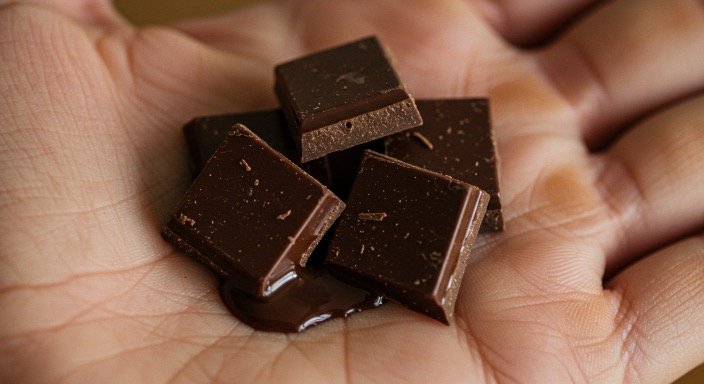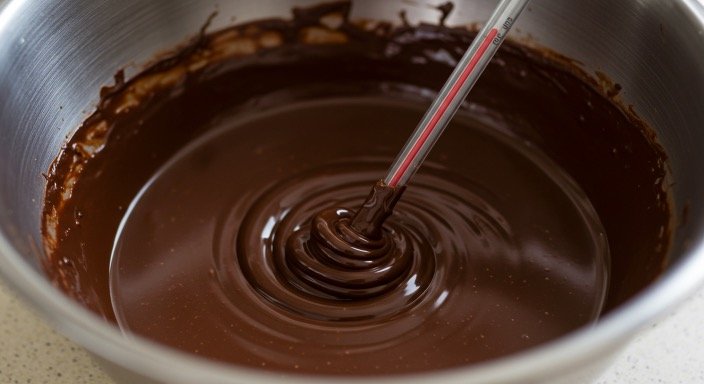Why Chocolate Melts in Your Hands
Have you ever wondered why a piece of chocolate feels cool and firm in its box but starts melting almost instantly once you touch it? It’s not your imagination — it’s pure science. Chocolate’s ability to stay solid at room temperature yet melt luxuriously in your mouth (or hands!) is one of the reasons it’s so irresistible.
In this post, we’ll explore why this happens, how the chemistry of cocoa butter makes chocolate so unique, and how you can keep it from turning into a sticky mess before you even taste it.
The Delicious Chemistry Behind Chocolate
At the heart of chocolate’s magic is cocoa butter — the natural fat extracted from cacao beans. What makes cocoa butter special is its unusual melting point, which falls between 86°F and 90°F (30°C–32°C) — just below the average human body temperature.
That means it stays perfectly solid in a cool box but melts beautifully the moment it touches your skin. According to a Linked In study, this narrow melting range is what gives chocolate its signature “snap” and smooth mouthfeel.
For more about storing chocolate properly, check How to Store Chocolate to Keep It Fresh: Tips from Experts.
When you hold a piece of chocolate, the gentle warmth from your hand liquefies the fat crystals in cocoa butter — causing that glossy melt we all love.
The Role of Tempering

Chocolate Melts
Chocolate makers carefully temper chocolate to control how cocoa butter crystals form. This process involves heating and cooling chocolate to very specific temperatures so it sets with a shiny surface and crisp snap.
If done right, the chocolate becomes stable enough to resist mild warmth — like sitting in its box or wrapper. If done incorrectly, however, the fat crystals form unevenly, making the chocolate dull, crumbly, or prone to melting too soon.
A Research Gate study confirms that perfectly tempered chocolate contains mostly “Form V” cocoa butter crystals — the ideal structure that balances firmness with meltability.
You can learn how this structure influences taste in Dark vs. Milk Chocolate: The Surprising Health Differences You Need to Know.
Why the Box Keeps It Solid
The reason your chocolate bar stays safe in its box is simple: controlled environment. Most chocolate packaging protects it from three things — heat, moisture, and light — all of which speed up melting or spoilage.
That’s why high-quality brands use foil liners or thick paper boxes. They reduce air exchange and keep the chocolate’s delicate crystal structure stable.
You can read more about protecting chocolate’s structure in Is Chocolate Gluten-Free? — where we discuss how manufacturing and packaging preserve purity.
So, while your hands easily reach 98°F (37°C), your chocolate box stays comfortably around 65–70°F (18–21°C) — the perfect preservation zone.
The Science of Melting

Chocolate Melts
When chocolate melts, it undergoes a process called phase transition — solid fat turning into liquid fat. Cocoa butter’s complex fat profile includes multiple triglycerides that melt at slightly different temperatures.
That’s why chocolate doesn’t melt instantly, but gradually softens from the edges inward. According to The ADS, this slow melt rate is key to its creamy mouthfeel, as each layer liquefies in sequence.
This principle also explains why melted chocolate works so beautifully in Chocolate Graham Crackers — smooth texture and balanced sweetness.
The mouthfeel and aroma release depend on this exact temperature control. It’s one of the reasons why chocolate is considered the “gold standard” of food texture science.
How Manufacturers Design Chocolate That Doesn’t Melt Too Fast
If you’ve ever noticed that some chocolates — especially candy bars — don’t melt easily, it’s not luck. Manufacturers tweak recipes by blending cocoa butter with other fats like palm oil or milk solids to raise the melting point slightly.
A Science Direct study found that substituting a small percentage of cocoa butter can increase resistance to heat without compromising flavor too much.
However, purists and chocolatiers often avoid such blends, as they can dull flavor complexity. That’s why artisan chocolate melts more readily — it’s purer.
You can read more about real vs. modified cocoa fats in Choco Milk Review: All What You Need to Know.
Why Chocolate Feels Cool to the Touch
Interestingly, chocolate often feels cool before it melts. That’s because cocoa butter has a relatively high heat capacity, meaning it absorbs warmth from your fingers before warming up itself.
A DailyMail explains that as chocolate melts, the thin fat film on your tongue changes phase rapidly, creating that cooling sensation we associate with luxury.
So, when chocolate first touches your hand, it absorbs just enough heat to begin softening — but when it reaches your tongue, it melts instantly into a luscious texture.
See how this temperature sensitivity affects texture in Bone Broth Hot Chocolate: The Surprising Superfood Drink You’ll Actually Love.
What Happens When Chocolate Gets Too Warm
If your chocolate melts fully and resets incorrectly, it can lose its structure — developing fat bloom (white streaks) or a grainy surface. This happens when fats recrystallize unevenly after cooling.
To avoid this, keep chocolate in a stable, cool area. The Bakers Authority recommends storage at 60–70°F with less than 50% humidity.
For practical tips, revisit How to Store Chocolate to Keep It Fresh: Tips from Experts.
If your chocolate does bloom, don’t panic — it’s still safe to eat! The change is purely cosmetic. You can re-melt and re-temper it to restore shine.
Why Your Mouth Is the Perfect Melting Environment
Chocolate melts so beautifully in your mouth because of body heat, saliva, and movement. The moment it touches your tongue, friction helps it liquefy, while saliva disperses the fats evenly across your taste buds.
It’s the same reason your Chocolate Chip Banana Bread tastes even better when served warm — temperature changes amplify flavor.
Tips to Prevent Chocolate from Melting in Your Hands
If you’re tired of sticky fingers, here are some quick ways to enjoy chocolate mess-free:
- Hold it by the wrapper or paper liner.
- Keep chocolate cool (not cold) before opening.
- Avoid sunlight or car dashboards.
- Don’t handle chocolate too long — enjoy it quickly!
Check The Best Chocolate Chip Cookies for ideas on turning leftover chocolate into melt-proof desserts.
The Takeaway
Chocolate’s ability to melt in your hands — but not in its box — is one of nature’s sweetest bits of physics. It’s a reminder that something as simple as temperature can completely change texture, flavor, and even emotion.
The next time you unwrap a bar, take a second to appreciate the craftsmanship and chemistry behind that smooth, melt-in-your-mouth experience. It’s not just food — it’s science you can taste.
For even more ways to enjoy chocolate without losing its perfect form, explore Sweet Freedom: How to Reduce Sugar and Unlock Better Health — because balance makes indulgence even better.
Chocolate Melts
Discover more chocolate wisdom on ChocoTalks.com
where every bite tells a story.
Chocolate Melts
Our Authority Sources
- Linked In : crystal science behind chocolates snap shine melt
- Research Gate “Form V” cocoa butter crystals
- American Chemical Society
- ADS – The Science of Melting
- Science Direct
- DailyMail chocolate melting and tongue changes.
- Bakers Authority Chocolate storage
- Sweet Freedom: How to Reduce Sugar and Unlock Better Health

